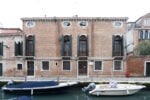Andrea Bruno – Progettare l’esistente
.jpg)
In occasione del trentennale del restauro del museo, il Castello di Rivoli offre un tributo all’architetto torinese Andrea Bruno (Torino, 1931).
Comunicato stampa
In occasione del trentennale del restauro del museo, il Castello di Rivoli offre un tributo all’architetto torinese Andrea Bruno (Torino, 1931).
Allestita negli spazi del terzo piano della residenza storica, la mostra ripercorre l’ampia e articolata attività professionale dell’architetto: dai primi progetti svolti negli anni Sessanta, tra i quali i rilievi e il consolidamento del castello abbandonato dopo la seconda guerra mondiale a Rivoli, al più recente progetto del restauro della Cattedrale di Bagrati in Georgia.
Da più di cinquanta anni Bruno si occupa del restauro di edifici storici, della progettazione di musei, della realizzazione di abitazioni private e del consolidamento e censimento di siti archeologici in tutto il mondo spesso sotto l’egida dell’Unesco, di cui è consulente dal 1974.
Andrea Bruno. Progettare l'esistente si articola in tre aree espositive. Il visitatore, giunto al terzo piano, viene accolto dall'effetto ottico e illusorio creato dall'accostamento tra lo sporto panoramico e la sua immagine. Il percorso, dal primo ambiente del sottotetto, si snoda poi attraverso le sale 38 e 37 che ospitano opere della collezione del museo in stretto dialogo con la prassi dell'architetto. Nel grande salone 36 è quindi allestita la storia della carriera professionale di Bruno, tra documenti originali, disegni, prospetti, fotografie e modelli delle principali opere realizzate, con una particolare attenzione al restauro del museo. La mostra continua nella sala 35 con un focus sull’Afghanistan e si conclude nella 34, con una nuova opera dalla collezione del museo.
For the thirtieth anniversary of the museum’s restoration, the Castello di Rivoli Museo d’Arte Contemporanea pays tribute to the architect, Andrea Bruno (b. Turin, 1931).
Installed in the rooms on the historic residence’s third floor, the exhibition is an opportunity to review the architect’s vast and complex career: from his first designs dating to the 1960s, including the reliefs and the consolidation of the Castle abandoned after World War II in Rivoli, to the more recent restoration of the Cathedral of Bagrati in Georgia between 2011 and 2013.
For over fifty years, Bruno has been engaged in restoring historical buildings, designing museums, creating residential homes, and consolidating and surveying archeological sites around the world often under the aegis of UNESCO, of which he has been a consultant since 1974.
The exhibition Andrea Bruno. Designing the Existent unfolds in three main display areas. Upon reaching the third floor, the visitor encountersan optical illusion resulting from the panoramic protrusion paired with its image. From the first room hosting the vault, the itinerary unfolds across the catwalk, into Rooms 38 and 37 that present works from the Museum’s collections in close communion with the architect’s practice.
The exhibition continues in Room 35, with a focus on Afghanistan and ends in Room 34, with a work from the museum collection.



